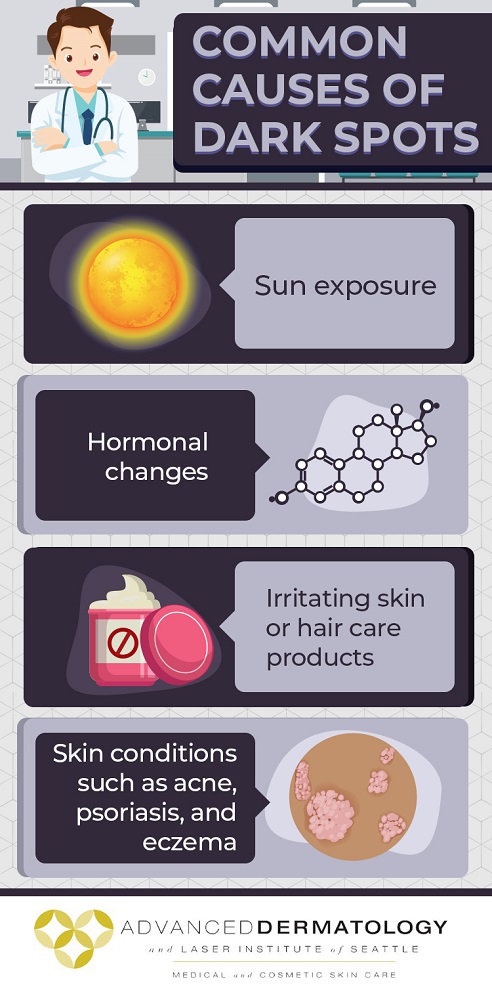 Dark spots and skin discoloration can happen to people of any skin tone. In fact, they’re one of the most frequently cited reasons why people with skin of color choose to see a dermatologist. In people with skin of color, they can be triggered by several causes. The ideal solution often depends on identifying the source of the issue.
Dark spots and skin discoloration can happen to people of any skin tone. In fact, they’re one of the most frequently cited reasons why people with skin of color choose to see a dermatologist. In people with skin of color, they can be triggered by several causes. The ideal solution often depends on identifying the source of the issue.
At Advanced Dermatology and Laser Institute of Seattle, our board-certified clinical dermatologist Dr. Steven Greene has more than 25 years of experience helping resolve his patients’ medical and aesthetic skin issues. He has worked extensively with patients with skin of color. If you have medium-to-dark-colored skin, he is attuned to your unique needs and will create a treatment plan to help give you the results you want.
This blog breaks down some of the causes of discoloration in skin of color, what you can do about discoloration, and how Dr. Greene can help.
What Causes Dark Spots in Skin of Color?
 People with medium-to-dark-colored skin often get dark spots and skin discoloration when something happens that makes their skin create more melanin, the substance that gives skin its color. In people who have skin of color, numerous things can trigger that melanin production, such as:
People with medium-to-dark-colored skin often get dark spots and skin discoloration when something happens that makes their skin create more melanin, the substance that gives skin its color. In people who have skin of color, numerous things can trigger that melanin production, such as:
- Acne
- Psoriasis
- A wound healing
- Medications
- Irritating skin or hair care products
- Hormonal changes
Dr. Greene can help identify the causes of the dark spots on your skin. Sometimes, if you recognize the source, such as by switching from an irritating hair care product to a gentler one, the discoloration may go away on its own in about 6 to 12 months.
However, if the discoloration has existed for a long time and is more rooted in your skin, it may not fade on its own for years. In these cases, the dark spots may need additional treatment.
At-Home Dark Spot Remedies for Skin of Color
The first thing you should do to treat your dark spots is always to wear sunscreen, even when it’s cloudy, raining, or snowing outside. Every time you leave the house, apply sunscreen everywhere that isn’t covered by clothing. This can help prevent further discoloration. Make sure you wear at least SPF 30 or higher.
If your dark spots don’t go away on their own, you can try using skin-lightening products to return those spots to your natural skin tone. Many of these are available over the counter.
Take care not to buy skin-lighteners that contain steroids. These can cause pimples and rashes, which could lead to more discoloration. Dr. Greene can recommend a product that is safe and effective.
Treatments for Dark Spots in Skin of Color
At Advanced Dermatology and Laser Institute of Seattle, Dr. Greene offers numerous treatments that can help restore your skin to its natural pigmentation. If at-home dark spot treatments aren’t enough, he can address your discoloration in a variety of ways.
Our dark spot treatments include:
- Chemical peels: Our facial and chemical peel options include Vi Peel, Microneedling, dermaplaning, microdermabrasion, and more. These treatments can address your dark spots and restore healthier, more youthful-looking skin.
- Laser therapy: We offer laser systems that can target dark spots and destroy the pigmentation that’s causing your discoloration without affecting the surrounding skin.
- HydraFacial: This treatment rejuvenates your skin cells to improve their elasticity, reduce the appearance of wrinkles, and lighten areas of darker pigmentation.
Contact Our Seattle Dermatologist Today
Dr. Greene has extensive experience working with patients with skin of color. When you come to him for your dark spots or discoloration, he will treat your skin with the care and precision you deserve.
Dr. Greene serves Seattle and nearby areas of Washington. Call (206) 402-4797 today to schedule a consultation.
